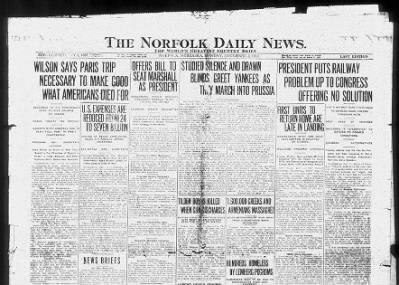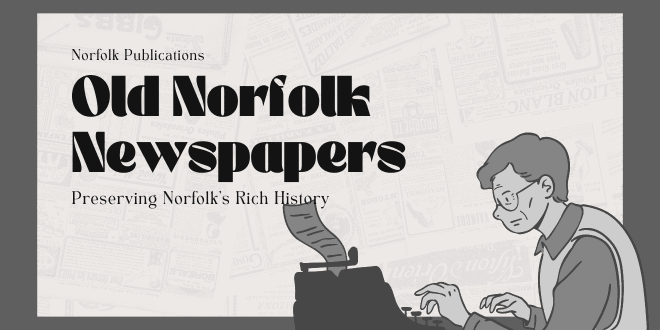Norfolk, known for its rich cultural heritage and spectacular scenery, has a deep-rooted record in display advertising that dates back several centuries. Old Norfolk newspapers are attractive pieces of history that accurately reflect the substance of the period in which they were printed. They are not only records of the previous.
From the earliest papers to the modern age, Norfolk media have played a vital role in documenting activities, preserving local customs, and shaping public discourse.
Old Norfolk Newspapers

In this article, we will examine the development of old Norfolk publications, their role in society, important papers, and the importance of preserving these historical riches.
Understanding the history of Norfolk’s print press is crucial to understanding its contribution to the local and regional environment, whether you’re a history lover or a curious readers.
The Birth of Norfolk Newspapers
Quick Beginnings in the 18th Century
Early in the 18th century, Norfolk media ‘ history was marked by major shifts in communication and information sharing. The Norfolk Chronicle, one of the state’s earliest papers, was founded in 1761 and immediately became a critical source of news for the local community. This biweekly publication delivered reviews on provincial politics, commerce, agriculture, and cultural events.
With the development of the printing press, papers became more accessible to the general public, which in turn fueled the need for more frequently and widely distributed publications. Although early newspapers in Norfolk were initially intended to be mainly distributed to wealthy, well-off sections of society, they slowly expanded their coverage to include a wider audience. These publications provided a platform for both standard presentations and public view, serving as a bridge between the local authorities and the people.
The Growth of Local Media
By the later 18th and early 19th centuries, many different media had emerged in Norfolk, catering to a wide array of readers. Publications like the Norfolk News and the Norwich Mercury gained acclaim in homes all over the area, covering everything from local gossip to global affairs. These magazines were frequently printed weekly or bi-weekly and contained articles, letters to the editor, and ads, reflecting the growing difficulty of culture.
As Norfolk’s people grew, so did the opposition among magazine publishers. The development of newspapers in this interval signaled a strong appetite for news and information, especially regarding social events such as elections, industry issues, and open policy debates.
Norfolk Newspapers ‘ Contribution to Society
Influencing Public Opinion
Old Norfolk media had a significant impact on shaping public opinion. Papers were frequently the only trustworthy source of information for the people during times of political turmoil or social change. Whether it was the Napoleonic Wars, the agrarian developments of the 19th century, or the fall of industrialization, media played a vital role in informing the public and stimulating conversation.
One of the more substantial effects of these papers was the Reform Act of 1832, a social movement that sought to reform the political system in Britain. Newspapers in Norway published articles and information about the action, giving voice to both sides of the debate. These publications were instrumental in gaining public support for reform, highlighting the influence of the media on social results.
Chronicling Daily Living
Old Norfolk media are reliable sources of information about everyday life in Norfolk, aside from major political events. From crime studies and court trials to local fairs and festivals, they kept track of everything. Ads for local businesses, disclosures of births, deaths, and marriages, and also detailed accounts of agricultural yields can be found within their pages.
Historical researchers can reconstruct a vivid portrait of Norfolk’s history through these seemingly uninteresting data. The rise and fall of business, shifts in population, and the changing social relationships are all captured in these publications, making them an invaluable tool for researchers and past enthusiasts alike.
Key Norfolk Newspapers
Norfolk Chronicle
The Norfolk Chronicle, which has been continuously published for more than two centuries, is one of the most significant newspapers in Norfolk’s history. This weekly newspaper, which was founded in 1761, is renowned for its comprehensive coverage of regional and national events as well as its extensive archives, which offer a glimpse into Norfolk’s past.
The Industrial Revolution and both World Wars were significant historical turning points for The Norfolk Chronicle. Its editorial style has evolved over time, keeping up with the regional political landscape’s changing needs. The Norfolk Chronicle‘s archives are still a valuable resource for scholars and history buffs today.
Norwich Mercury
The Norwich Mercury was one of the region’s first newspapers to be published since it was founded in 1714. Over its long history, the Mercury became a trusted source of news and opinion, particularly in the 19th century, when it covered political reform, social issues, and economic changes in Norfolk.
The Norwich Mercury bridged the gap between the larger events taking place in the country and the common concerns of Norfolk’s residents by focusing on both national and local news. This combination made it a well-liked option for those who wanted to stay informed about both local and global events.
Norfolk News
The Norfolk News, established in 1845, was a newspaper that catered specifically to Norfolk’s working-class population. While other newspapers were often aimed at wealthier or more politically connected audiences, the Norfolk News made a concerted effort to appeal to the everyday reader, covering labor issues, local business, and public services.
The paper also championed social causes, advocating for improved working conditions, better education, and public health initiatives. Its commitment to addressing the needs of the average person made it a significant component of Norfolk’s media landscape.
The Evolution of Norfolk Newspapers
Technological Advancements
As technology evolved, so did the way newspapers were produced and distributed. In the 19th century, the introduction of steam-powered printing presses revolutionized the industry, allowing newspapers to be printed more quickly and in larger quantities. This technological advancement increased the availability of newspapers to a wider audience in addition to lowering production costs.
By the 20th century, newspapers had embraced other forms of media, such as photography and illustration, to enhance their reporting. Newspapers like the Eastern Daily Press started incorporating more visual elements to draw readers in and make the reading experience more engaging.
The development of radio and television in the middle of the 20th century created new difficulties for print media, but Norfolk newspapers adapted by focusing on in-depth analysis and local stories that other media outlets were less qualified to cover.
The Digital Revolution
The newspaper industry underwent the most significant changes with the advent of the internet in the late 20th and early 21st centuries. Traditional print newspapers faced fierce competition from online news sources, making many of them to create digital versions of their publications.
Newspapers like the Norwich Evening News and Eastern Daily Press continue to have active online presences, providing current news and interacting with readers via social media. Norfolk newspapers can now be read on a global scale while preserving the local while embracing the global.
The importance of local news has not decreased despite the rise of digital media, which has caused many print publications to face financial difficulties. Norfolk newspapers continue to be important news sources for residents, covering both the big picture and the big picture that affect the community.
Preservation of Old Norfolk Newspapers
Archiving and Accessibility
Old Norfolk newspapers must be preserved in order to keep the historical record. Many of these publications are archived in local libraries, universities, and historical societies, where they are accessible to the public for research and educational purposes.
Recent initiatives have been made to digitize old newspapers, making them more accessible to both researchers and the general public. Websites like the British Newspaper Archive have a significant impact on the preservation and dissemination of these important historical documents, enabling visitors to explore Norfolk’s rich history from all over the world.
The Value of Historical Newspapers
Anyone interested in local history will find invaluable resources in Old Norfolk newspapers. They provide unique perspectives on the political, social, and economic issues of the past as well as a snapshot of daily life that are absent from official histories and academic writings. For genealogists, old newspapers offer an unparalleled wealth of information about family histories, including announcements of births, marriages, and deaths.
It is impossible to overstate the value of keeping these historical documents intact. It is crucial to keep these recognizable historical documents safe as we enter the digital era.
Conclusion
Old Norfolk newspapers are more than just records of the past; they offer glimpses into the world as it once was. These publications, which range from the Norfolk Chronicle to the Norwich Mercury, have influenced public opinion, captured daily life, and preserved the distinctive character of Norfolk for generations to come.
It is crucial to continue preserving and supporting these historical treasures as we approach the future. Whether through digitization efforts, local archives, or simply by reading and sharing their stories, we can ensure that the rich history of Norfolk’s newspapers lives on for generations to come.
By engaging with Norfolk’s newspaper history, we not only preserve the past but also strengthen our connection to the community. Old Norfolk newspapers are a testament to the written word’s unwavering power and ability to accurately capture a place and time.
 Norfolk Web Publications Web Publications in Norfolk!
Norfolk Web Publications Web Publications in Norfolk!

